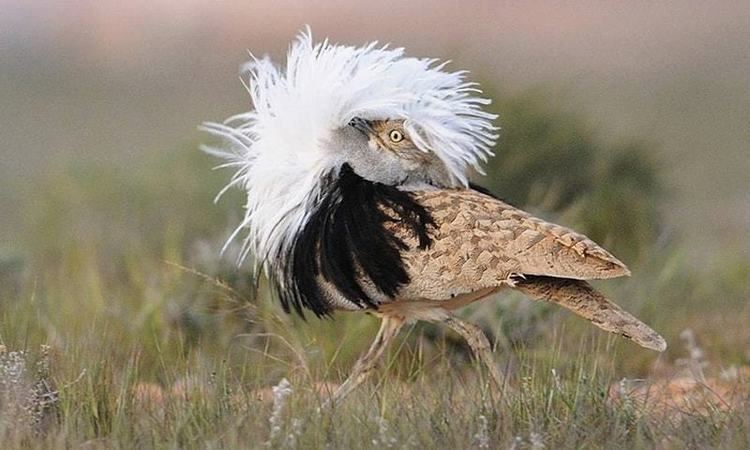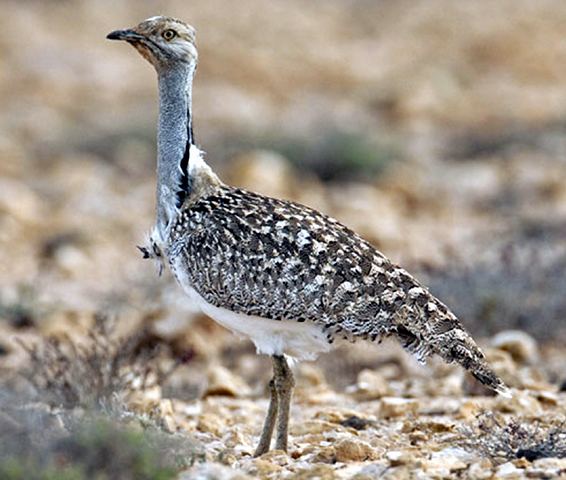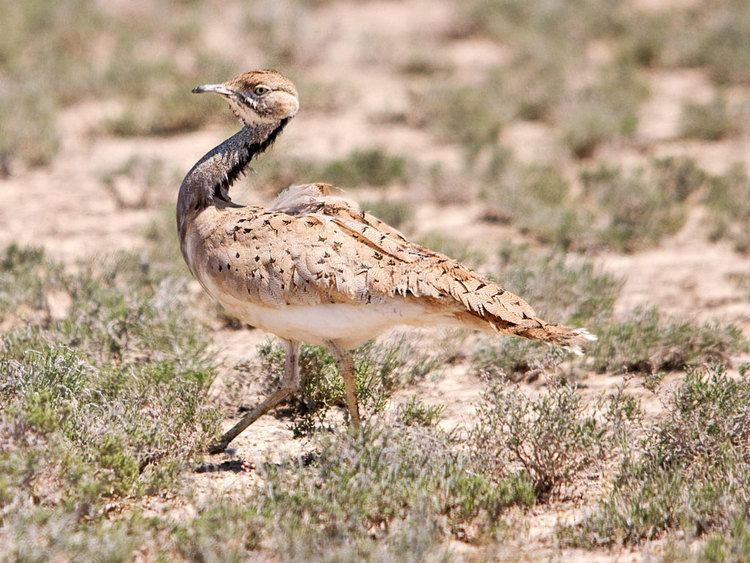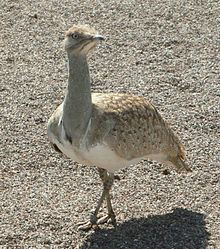Rank Species | Family Otididae Scientific name Chlamydotis undulata Phylum Chordata Order Bustard | |
 | ||
Similar Bird, Bustard, Chlamydotis, Curlew, Great bustard | ||
Houbara bustard provincial bird of balochistan
The houbara bustard or North African houbara (Chlamydotis undulata) is a large bird in the bustard family. This bustard is found in arid habitats spread across northern Africa and Southeast Asia with a population on the Canary Islands. They are dull brown with black markings on the wings with a greyish neck and a black ruff along the side of the neck. Males and females appear very similar but males are larger and heavier. This species formerly included MacQueen's bustard which is found further east and sometimes known as the Asian houbara as a subspecies.
Contents
- Houbara bustard provincial bird of balochistan
- Description
- Taxonomy
- Distribution and habitat
- Breeding
- Feeding
- Status
- Status and conservation
- References

Description

The houbara bustard is a small to mid-sized bustard. It measures 55–65 cm (22–26 in) in length and spans 135–170 cm (53–67 in) across the wings. It is brown above and white below, with a black stripe down the sides of its neck. In flight, the long wings show large areas of black and brown on the flight feathers. It is slightly smaller and darker than MacQueen's bustard. The sexes are similar, but the female, at 66 cm (26 in) tall, is rather smaller and greyer above than the male, at 73 cm (29 in) tall. The body mass is 1.15–2.4 kg (2.5–5.3 lb) in males and 1–1.7 kg (2.2–3.7 lb) in females.
Taxonomy

The former Asian subspecies, C. u. macqueenii, has now been split as a full species, MacQueen's bustard, Chlamydotis macqueenii. These two species are the only members of the Chlamydotis genus. The Canarian houbara is the subspecies Chlamydotis undulata fuertaventurae. The dividing line between the two Chlamydotis species is the Sinai peninsula. Based on the rates of divergence of mitochondrial DNA sequences, the two subspecies are thought to have separated from a common ancestor around 20 to 25 thousand years ago. The separation from MacQueen's bustard is older at 430 thousand years ago.

The British Ornithologists' Union's Taxonomic Records Committee's decision to accept this split has been questioned on the grounds that the differences in the male courtship displays may be functionally trivial, and would not prevent interbreeding, whereas a difference in a pre-copulation display would indicate that the two are separate species. The committee responded to this scepticism, by explaining that there are differences in both courtship and pre-copulation displays.
Distribution and habitat
The houbara bustard is found in North Africa west of the Nile mainly in the western part of the Sahara desert region in Mauritania, Morocco, Algeria, Tunisia, Libya and Egypt. Some old records exist from Sudan as well. A small population is found in the Canary Islands. The Asian houbara or MacQueen's bustard which was earlier included in this species occurs east of the Sinai Peninsula. The North African species is sedentary unlike the migratory northern populations of MacQueen's bustards.
Breeding
Like other bustards, this species has a flamboyant display raising the white feathers of the head and neck and withdrawing the head. Two to four eggs are laid on the ground. It hardly ever uses its voice.
Feeding
This species is omnivorous, taking seeds, insects and other small creatures.
Status
Subspecies fuertaventurae of the Canary Islands is highly restricted and endangered. A 1997 survey found a total population of about 500 birds.
Status and conservation
Threats to Houbara bustards include hunting it for food. The North African houbara bustard declined in populations in the two decades before 2004, but unlike its near relative the Asian houbara or MacQueen's bustard, has been on the increase since. Although hunted both by falconers and by hunters with guns, the extent is much less than that faced by MacQueen's bustard in the middle east and west Asia.
The International Foundation for Conservation and Development of Wildlife (IFCDW) is a major conservation and breeding project established with funds from Prince Sultan Bin Abdul Aziz AlSaud and based near Agadir, Morocco. The centre releases captive bred populations to boost wild populations. Similar projects breed MacQueen's bustards using artificial insemination are also carried out in the United Arab Emirates.
